ILLUSTRATIONS
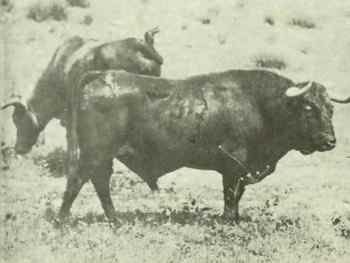
At twenty-two years the horns are splintered; the eyes are slow and all the weight has gone forward and away from where eight hundred and twenty-two sons came from to the ring so that in the end the hind quarters are light as a calf's but all the rest is built into the bull's own monument.
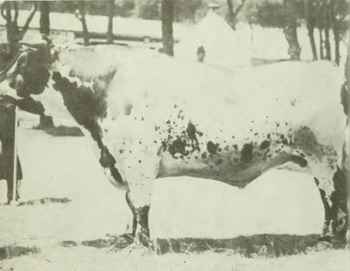
While here we have the ox built for beef and for service who might have been president with that face if he had started in some other line of work. He differs from the fighting bull in this, as well as in his general shape; his hoofs are large and broad, his tail is thick and the hairs are flaxy, not silky; he is built high instead of low and there is no hump of muscle that runs from just behind his horns until the middle of his back. He may work hard all his life or he may be made into beef early in his career but he will never kill a horse. Nor will he ever want to. Hail to the useful ox; a friend and contemporary of man.
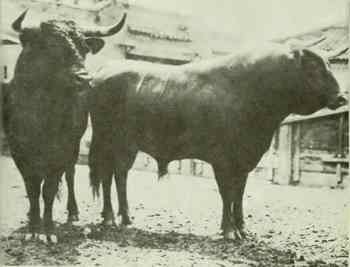
The hump of muscle in the neck rises in a crest when the bull is disturbed. It is his tossing muscle and when the bull carries his head as high as this one in the picture a man could not reach over the horns with a sword. This muscle must be tired for the man to kill the bull properly and it is in the process of tiring this muscle so that a man may kill him by putting a sword in from in front high up between the bull's shoulder blades that the bullfight consists.
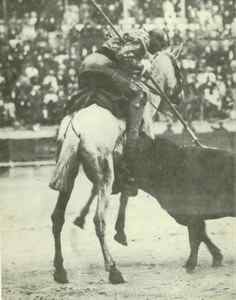
Zurito, from Cordoba, one of the greatest picadors who ever lived, shooting the stick a little back of where it should go, having let the bull get the horn in so he may be well pegged. The style is perfect, the execution is cynical, and the horse, who will be dead very shortly (if you look closely you may assure yourself of this), is not panicky because those knees have convinced him that he is being properly ridden. The horses, incidentally, mostly come from the United States where they are bought at the St. Louis and Chicago markets at five dollars or less a head and shipped through Newport News, a shipload at a time, to Spain. The bull is rather cowardly, otherwise Zurito would not have thrown his hat, seen on the ground, to provoke a charge. Knowing the charges will be few may account for him pegging the bull further back than would be necessary ordinarily.
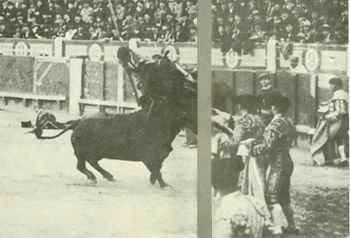
Veneno, killed in the Madrid ring, pic-ing a brave bull, leaning forward onto the stick, the matadors (standing on the right) watching to see where and how the picador will fall and how the bull will turn since they must take him out and away with the capes.
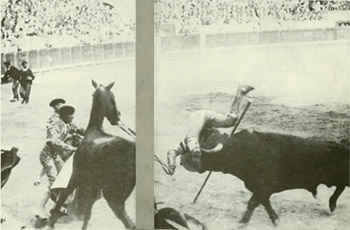
This is what happens when the saddle girth breaks and the picador falls onto the horns. Chicuelo, the matador whose face is partly hidden by the hat, seems a little late in starting in but photographs are very tricky and the fact the picador's hat is still on shows he has just arrived on the horns, which are unusually short. Only the right horn has penetrated. The other matador is Juan Anllo, Nacional II, and the chances are that he will make the quite although if the man falls from the horn when tossed and the bull sees the horse before his horn finds the man the horse will make the quite.
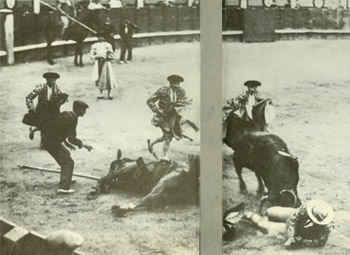
Here every one is coming in to make the quite; even El Gallo, the furthest on the left whose face shows that he does not like the looks of things at all. The bull, trying to gore too fast, is bumping with his nose.
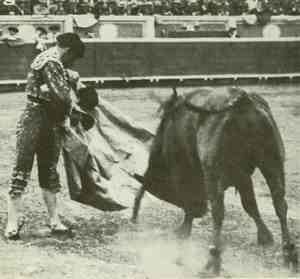
Veronica by Juan Belmonte. Having taken the bull out away from the fallen picador the matador passes him with the cape.
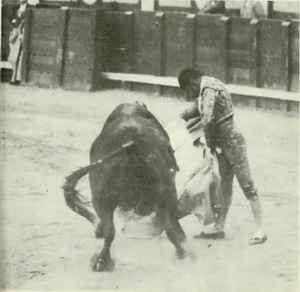
Veronica to the right made by Gitanillo de Triana. This is the second movement in the process of passing the bull by veronicas.
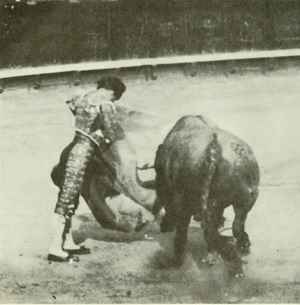
Veronica to the left by Enrique Torres. This is the third movement in passing a bull by veronicas and the three matadors shown making the passes are, with the addition of Felix Rodriguez, the finest artists with the cape the ring has known. Belmonte has not the complete suavity and the low, slow swing of the other three but his is the original style on which they have improved.
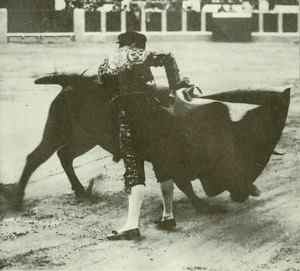
Gathering the cape toward him at the end of a series of veronicas to wind the bull around him like a belt, his right leg pushed toward the bull in that bent slant, which will be copied but never made truly until another genius comes in the same twisted body—the media veronica of Juan Belmonte. This pass is the end of a series of veronicas and serves to fix the bull in place and allow the man to walk away.
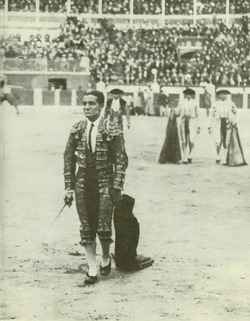
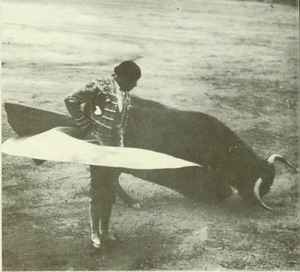
Cagancho sculpturing with the cape. Finishing a series of veronicas with a rebolera, he has turned the bull so short that he has brought him to his knees.
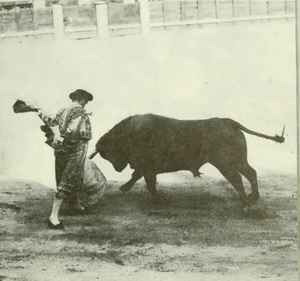
The gaonera as performed by its inventor, Rodolfo Gaona.
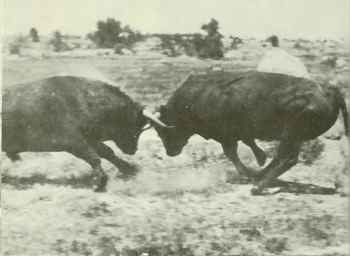
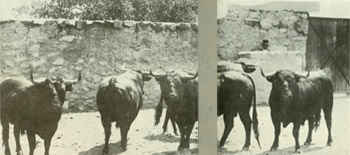
Five sons of Diano the seed bull
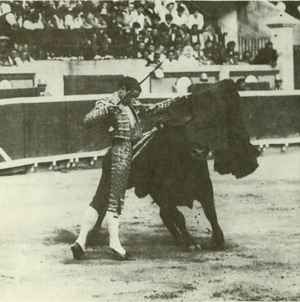
Vicente Barrera in a pase de pecho. This picture and the one below show the basis of the emotion in bull fighting. The emotion is given by the closeness with which the matador brings the bull past his body and it is prolonged by the slowness with which he can execute the pass.
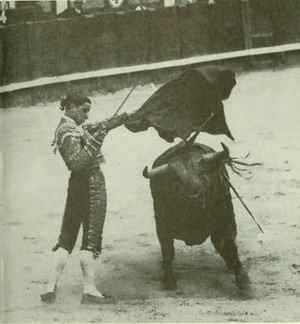
This is Vicente Barrera in the same pass as in the photograph above except that here instead of letting the horn go by his chest he has pulled away prudently so that with the danger removed man and bull do not form one group but are separate entities held together neither by emotion nor by plastic line. A position which would be artistically correct becomes ridiculous without the danger of the horns and the necessary bulk of the bull to give it dignity.
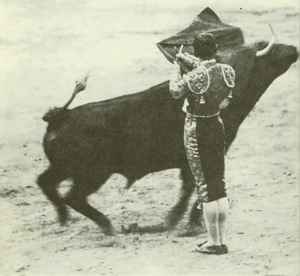
Grace and the lack of it in the ring are in this picture of Cagancho and the following one of Nicanor Villalta performing the same pass, an ayudado por alto, in their respective fashions.
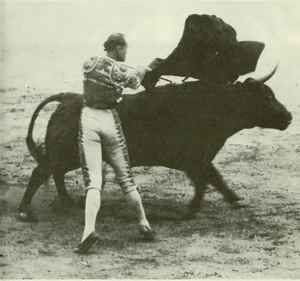
Nicanor Villalta, in the pass Cagancho has made in the photograph above. Villalta can be much more anti-esthetic than this but this is a fair example of his praying-mantis manner.